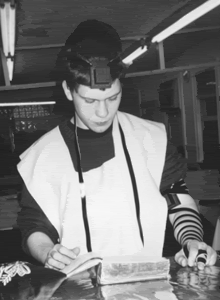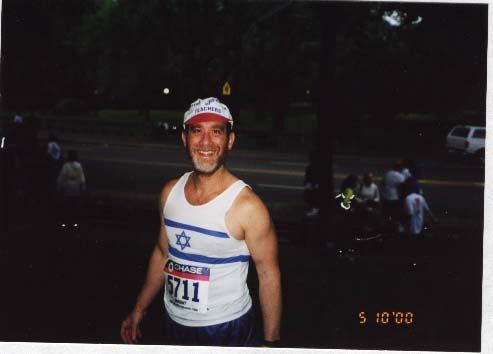In Memoriam: Rabbi Meir Kahane
Real Torah vs Fake Toyrah
We recently commemmorated the twentieth yahrzeit of Rabbi Meir Kahane hy"d, murdered by an Arab terrorist in New York in the fall of 1990. I came under his influence as a high school student in the 1960s, through his columns in the Jewish Press and his numerous public appearances in Brooklyn. I had enrolled in one of the karate programs that his Jewish Defense League had set up in Brooklyn. One day after class Rabbi Kahane came in and spoke to us. He told us it was high time young Jewish men were doing this, that if we were to survive in our changing neighborhoods rife with anti-Jewish assaults we would have to break the stereotype of the Jewish "patsy" (his word), gentle, scholarly, unaccustomed to (and repelled by) fighting, unable or unwilling to defend himself. This was not news to me. A while before, in 1967, I had begun lifting weights and transforming myself from a sickly little boy into a robust young athlete. I had begun living "muscular Judaism" before becoming aware of the phrase.
Rabbi Kahane taught us that the Torah as studied and lived by generations of Jews in galut (exile) was not the genuine article. I might add that even the typical European pronunciation of the word, Toyrah (as if a yod followed the holam), has an unmanly, kvetchy ring to it. Rabbi Kahane taught us that there is nothing Jewish about being physically weak, unable to stand up for ourselves in the street, and ultimately being herded naked into gas chambers. In fact, it was the essense of hillul Hashem (desecration of God's Name). I am reminded of visiting the Holocaust memorial at Mount Zion in Jerusalem on my first trip to Israel with my family for my Bar Mitzvah. The guide pointed to several bars of soap in the front and told us that they were made from the bodies of Jewish victims and were inscribed with the German initials for "Pure Jewish Fat." It would be laughable if it were not so disgusting and tragic. Since then, all soap, ashes and other derivatives of Jewish bodies at that memorial were properly buried. The Germans discontinued soap manufacture because it was uneconomical, not due to any shortage of Jewish fat. Neither is there any shortage of Jewish fat today; look around in shul and you'll see more pregnant men than pregnant women. Well, nobody is going to get much soap from this (58-yr-old) Jew. The real Torah, according to Rabbi Kahane, presumed normal Jews and a normal Jewish nation. Jews who do not sit all day and half the night hunched over books. Jews who work Jewish soil in the hot Israeli sun. Tough, strong Jews who crush any enemy that dares attack us. The kind of Jews that we meet in Tanakh, the study of which, he taught, is sadly neglected in most yeshivot [but not in my alma mater, Yeshivah of Flatbush].
Cut to 2010. I'm in the bakery shopping for Shabbat and pick up a free copy of the Five Towns Jewish Times. I turn to an article titled "Olympians We're Not" by one "Talmid X," who is spending the now-customary post-high-school year at an Israeli yeshiva. The author describes his physical breakdown caused by sitting for most of the day in a "beis medrash" (Would someone please tell me how a hirik got transformed into a segol?). He tells of how a fifteen-minute stint in the Israeli sun heaving around "enormous sacks of potatoes" had him spending the rest of the afternoon in a bathroom stall suffering from dehydration (and presumably diarrhea). He describes the Israeli summer sun as "boiling", and an "oven. . .set at approximately two million degrees." Well, guess what? I was in that Israeli sun in 1974, when I was roughly his age. I spent the major part of the day not hunched over books but picking grapes in Kibbutz Sde Eliyahu in Emek Bet She'an. I ate like a farm hand because that's what I was, and I did not gain a pound. When I and my friends were not working in the fields we were traipsing all over the country, climbing hills and exploring caves. We traveled in a pickup truck, not an air conditioned bus. We hiked up Masada, the cable car being for weaklings only (when it passed overhead, we called out "too-reest, too-reest"). Talmid X, at best, engages in over-the-top hyperbole that discredits the rest of what he has to say: Just how heavy were those "enormous sacks of potatoes" that broke him in fifteen minutes? At worst, he commits the sin of the meraglim, the spies sent by Moshe Rabbeinu who returned with a report full of lashon hara about Israel. Ovens were the fate of weak Jews before there was an Israel. The Israeli sun is wonderful. It's beautiful. It challenges boys and, if they rise to it, turns them into men. The human organism is designed to function in the heat. Our ancestors made their living running gazelles down to exhaustion in the hot African sun. If 15 minutes in the sun dehydrated Talmid X, then the problem is Talmid X, not the sun. Diarrhea is most likely the result of eating food that was not properly refrigerated, though dehydration can make it worse. At any rate, Imodium works like a charm. Here are a few pointers for managing summer heat.
A Jew is commanded to take care of his/her health and avoid behavior that will make him sick, e.g. smoking and sedentary living. Just as we cannot say that we're too busy learning and have no time to put on tefilin, we can't say that we're too busy learning to keep ourselves healthy. If the yeshiva does not give you time to exercise, then make the time. Even if it means you arrive late for a shi'ur or skip one. Sick Jews learn sick "Toyrah," and dead Jews don't learn any. Get up a bunch of friends and work out together. Your yeshiva probably has a mashgiah ruhani; make yourself the unofficial mashgiah gufani. You might find yourself gaining fresh insights into your learning while you're running around in your underwear; strange and beautiful things happen when your heart's pumping rhythm to your brain. You might even want to carry around one of those voice-activated recorders to record those insights, flesh them out when you get back and surprise whoever is riding you for missing shi'ur. The worst thing that can happen is you'll be kicked out of that yeshiva. So? Find another one, one that teaches the real Torah and not the distorted and corrupt Toyrah.
Labels: education, evolution, health, Holocaust, Israel, manliness, obesity, Running, smoking, strength, summer, Tanakh, tefilin, Yeshivah of Flatbush, yeshivot, Zionism




